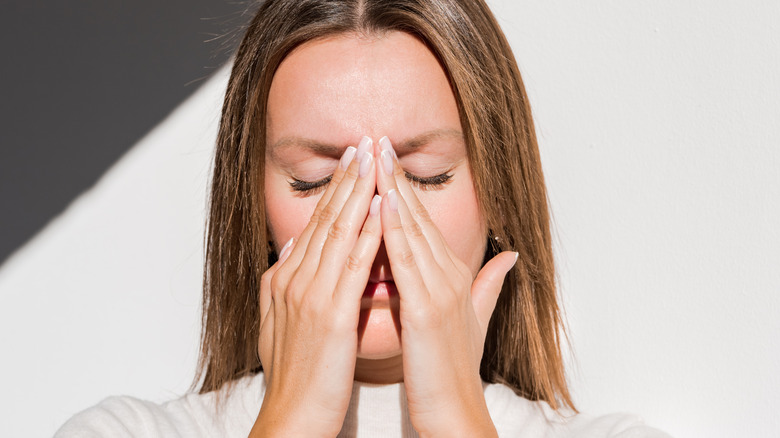Craniosacral therapy, or CST, is a hands-on technique used to treat a number of central nervous ailments. The method involves light physical touch to promote movement of fluids and membranes (via Cleveland Clinic). Craniosacral therapist Vivianne Garcia-Tuñón described the craniosacral system as “the cranium, spine and sacrum” all connected by “dura mater, a membrane of the body’s deepest fascia.” The main focus of the therapy is to release the body’s fascia or connective tissues (via Byrdie).
The technique was first introduced in the 1970s by osteopathic physician John E. Upledger and, according to Garcia-Tuñón, it’s best used for clients looking to “address and treat a variety of symptoms and dysfunctions — including both chronic and acute conditions.” While CST’s effectiveness has been called into question by modern medical professionals (via McGill University), a 2012 study found the treatment highly successful in reducing symptoms of migraines (via Healthline). According to the Cleveland Clinic, CST is most often used to treat chronic pain like fibromyalgia, migraines, epilepsy, multiple sclerosis, and post-concussion syndrome.
So how can you get started? A standard CST session ranges anywhere from $70 to $170 (via Byrdie), but if that price seems too steep, Wellness Embodied Cairns Physiotherapy has a few DIY techniques to achieve relief from the comfort of your own home.
(Though this type of bodywork is similar to receiving a gentle massage, it’s not recommended for everyone. Consult a medical professional before receiving CST if you have blood clots, cerebral swelling, or a recent concussion).
Begin your craniosacral therapy with deep breaths to promote grounding
Craniosacral therapist Suzanne Rath has a number of self-release techniques she uses to manage clients’ stress and anxiety. The first one she introduced in a YouTube video is breath work. Begin your DIY session with deep breathing to promote grounding. Place your hands on your ribs to ensure you’re breathing from your belly rather than your chest, and breathe in for a count of six before breathing out for a count of eight. According to Rath, long exhales are key to calming the autonomic nerve system.
Moving forward, in order to confirm you’re using the right amount of pressure with your CST work, Rath recommended placing a coin on the back of your hand. The pressure you use from now on should be even less than that of the coin. With that in mind, place your finger tips on your forehead and gently rest them on your frontal skull before drawing them slightly away.
“Try to imagine your hands are fans,” Rath explained. “Direct the energy, or fans, toward your forehead.” Continue with this imagery of turning the fans off, reversing the energy and repeating the cycle. The aim here is to decompress the frontal bones.
Release temporal and nasal bones to relieve sinuses
The next exercise craniosacral therapist Suzanne Rath introduced is helpful for relieving sinus issues and headaches. Release the temporal bones by place your finger tips mid-way up on the outside of your ear lobes and imagine pulling energy out and back. Be sure not to actually pull your ears as this will elicit more pressure than necessary. Rath recommended performing this technique while lying down to ensure your shoulders stay relaxed. Remember the fan imagery as you pull energy in, pause, and pull energy out.
Another method for sinus relief involves accessing the nasal bone. Gently rest your pinky fingers just above the nose, in between the eyebrows, and slowly draw energy forward to create space. If you’re looking to increase effects of CST, try using essential oils along with these exercises. Rath instructed viewers to select an oil with anti-inflammatory properties, such as lemon grass or bergamot. The oils can either be burned or be applied topically to the soles of the feet or the afflicted area.
And if you feel nothing after these exercises, don’t be discouraged. Healthline stated that it takes between three and 10 craniosacral sessions before clients begin seeing results. Happy healing!
Source: Read Full Article



